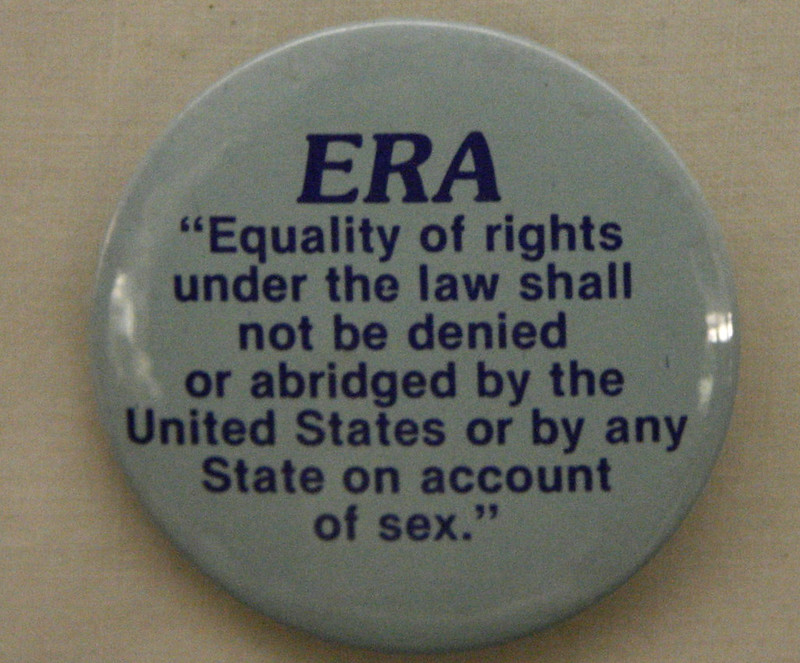This is the second in a multi-part series examining the half-century fight to add women to the U.S. Constitution—and a game plan on where we go from here
Read Part 1: “We Want In!” here. And check back every Wednesday for a new installment.
Part 2: A Long History of Obstruction, Delay and Trickery
Back in the early 1970s, when there were only 15 women in Congress—two in the Senate and 13 in the House—powerful male leaders of key House and Senate committees blocked votes on the Equal Rights Amendment.
The most powerful opposition—says Feminist Majority Foundation president Eleanor Smeal, who for part of the 1970s and ’80s was president of the National Organization for Women (NOW), which led the ERA fight—were business interests, especially the insurance industry, which opposed equality because sex discrimination is highly profitable.
“‘Women’s equality’ is not just words,” Smeal says. “It means real things, especially in the area of money. It means you have to stop discriminating against women in employment and in annuities, life insurance and health insurance. It involves billions and billions of dollars.
“It was one hell of a fight,” Smeal continues. “We marched, we picketed, we demonstrated. We had sit-ins. People were arrested. Some women went on hunger strikes. Every nonviolent protest that could be done was done. NOW had a silent vigil on the steps of the Senate, around the clock.”

Women’s protests finally got the ERA out of committee in 1971, but with a seven-year ratification time line in the preamble to the amendment. So the women’s movement fought tooth and nail to quickly win state ratifications.
Hawaii ratified within hours of Congress approving the ERA, and other states soon followed. In many states, however, business interests and elected state legislators—overwhelmingly men—blocked the ERA from a vote.
By the end of the seven-year time line, the amendment fell three states short of ratification. Feminists battled in Congress to pass an extension of the time line, which they did until 1982, but no additional states voted to ratify the ERA—until 2017.
After Trump became president, the fight for the ERA became more urgent. The massive rollback of women’s rights and Trump’s appointment of archconservatives Neil Gorsuch and Brett Kavanaugh to the U.S. Supreme Court made it clearer than ever that women need explicit protection for their equal rights in the U.S. Constitution.

Feminists turned with laser focus to a three-state strategy—seeking three more states to ratify the amendment and then a congressional joint resolution to remove the time line. The strategy was inspired by the ratification of the 27th Amendment (relating to salaries for members of Congress), which Congress had originally approved in 1789.
After Michigan became the 38th state to ratify the 27th Amendment in 1992, Congress passed a joint resolution agreeing that the amendment was validly ratified.
But as feminists sought three more state ratifications, mostly male conservative leaders in state legislatures once again refused to allow the ERA out of committee. So feminists focused on electing more women into office and flipping legislatures from red to blue, most recently succeeding in Virginia.
In Nevada, with the election of a record number of women and people of color in 2016, Democrats took control of the legislature. Under the leadership of state Sen. Pat Spearman, the new Democratic majority ratified the ERA in 2017.
In spring 2018, Illinois ratified the ERA after a strong pro-ERA movement succeeded in pressuring the Democratic speaker to finally allow a vote on the amendment.
Weeks after Virginia’s ratification this year, state Attorneys General Herring, Kwame Raoul (Ill.) and Aaron Ford (Nev.) filed suit to ensure that the Equal Rights Amendment would be added to the Constitution. These three AGs argue that under Article 5, which sets out the process to amend the Constitution, a proposed constitutional amendment automatically becomes part of the U.S. Constitution as soon as it is ratified by the legislatures of three-fourths of the states. Many constitutional law scholars agree.
Erwin Chemerinsky, dean of UC Berkeley School of Law, told Ms., “Congress set the time limit, Congress can modify the time line.
“It’s really important that the time limit was not in the text of the ERA itself,” he continues. “The time limit was part of a preamble before the text of the amendment. The amendment itself is ratified by the states. The preamble is not ratified by the states. If Congress can set the deadline in something other than the text of the amendment, why can’t Congress change the deadline it set?”
Constitutional law scholar and former dean of Stanford Law School Kathleen Sullivan agrees that the time line is not binding.
“Article 5 provides no barrier to Congress changing its mind, either eliminating or extending the deadline,” Sullivan says. “And that’s not a judicially reviewable decision. That’s a political question, and not something that a court can come in and second-guess. So if Congress were to pass a bill to remove the deadline, then that decision would be final and not reviewable by the courts. Nothing in the Constitution says that ratification must be synchronous, contemporaneous or bounded within any particular time frame.”
In February, 20 state attorneys general wrote an open letter in agreement; they called on Congress to remove the arbitrary time line on the ERA and affirm that the amendment is now part of the Constitution. Conservative state AGs, on the other hand, are arguing it has been too long since Congress passed the ERA.
“That is decisively refuted by the history of the 27th Amendment,” Sullivan says. “It was proposed by the first Congress and ratified two centuries later. There’s no Article 5 requirement that the states ratify in a particular period of time. The amendment should become effective upon the ratification of the 38th state.”
Opponents also argue that four states—Idaho, Kentucky, Nebraska and Tennessee—have voted to rescind their ratification of the ERA. And South Dakota stated its ratification would simply lapse after 1979. But historical precedent suggests that states cannot do so. After the Civil War, two states rescinded their ratification of the 14th Amendment, but Congress refused to recognize these rescissions.
“States that rescinded their ratification were counted toward the three-quarters of states necessary for ratification of the 14th Amendment,” Chemerinsky notes. “That indicates that states that have rescinded can still be counted.”
Sullivan agrees: “Article 5 speaks to ratification but not rescission. Article 5 describes a one-way ratchet. It does not provide for a two-way ratchet for going in and out of the process.”
“Ultimately, the Constitution and Supreme Court precedent leave to Congress the question of when an amendment is properly ratified,” Chemerinsky adds. “If Congress by joint resolution says the ERA is part of the Constitution, then it is.”
Feminists are now focusing their efforts on the U.S. Congress. The huge electoral victories for women and Democrats in the U.S. House of Representatives in 2018 paved the way for advancing the ERA in Congress. Women were elected to a record 23 percent of House seats, and Democrats gained 41 seats.
This year, Rep. Jackie Speier (D-Calif.) introduced a joint resolution to remove the arbitrary time line for the ERA.
“This is very simple,” Speier said during the House floor debate. “Women want to be equal, and we want it in the Constitution. … Women of America are done being second-class citizens. We are done being paid less for our work. Done being violated with impunity. Done being discriminated against for our pregnancies. Done being discriminated against simply because we are women.”
Under the leadership of Speaker Nancy Pelosi (D-Calif.), the House voted on Feb. 13 to pass the joint resolution with a bipartisan 232–183 vote (five Republicans voted with Democrats in favor of the legislation).
“With this resolution, we take a giant step toward equality for women, progress for families and a stronger America—because we know when women succeed, America succeeds,” Pelosi said at a press conference ahead of the vote.
“Our message here today is quite simple,” added Speier, holding up a pocket-size copy of the U.S. Constitution. “We want in.”
Sens. Ben Cardin (D-Md.) and Lisa Murkowski (R-Alaska) introduced a similar resolution in the Senate. In response to the Justice Department’s opinion letter, they released a joint statement arguing that Congress certainly has the authority under Article 5 of the Constitution to set and change deadlines for the ratification of constitutional amendments, and has done so on numerous occasions.
“There is no reason to put a time limit on achieving equality under the law,” they wrote.
Because Sen. McConnell has indicated he would block the resolution— he says he’s “personally not a supporter” of the ERA—Democrats must flip the Senate in the November election in order to secure passage of the resolution.
Keep reading:
This piece is excerpted from the Spring 2020 issue of Ms.
Become a Ms. member to read the rest—and get even more of our feminist reporting and analysis delivered to your door, or to your mobile device, each time we release a new issue!





